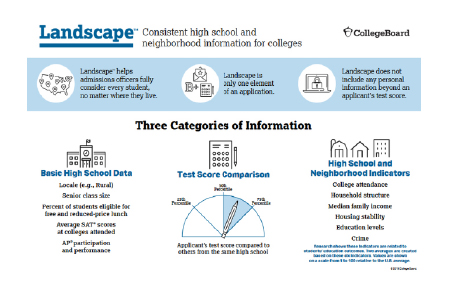College Board replaces controversial adversity score with Landscape
SAT no longer to have adversity scores after backlash

The College Board
Landscape looks at indicators such as school data
Months after the College Board announced its controversial SAT “adversity score,” the company cancelled the implementation of this feature amid criticism over its attempt to simplify obstacles students face into a single number.
The adversity score was piloted as part of the College Board’s Environmental Context Dashboard. The Dashboard could be seen next to a student’s SAT score to provide insights into why specific districts may perform higher or lower.
The number was comprised of two factors in a student’s education: the school environment and the neighborhood environment.
This score was on a scale of 1 to 100, with lower adversity scores representing more privileges and opportunities and higher numbers indicating obstacles, such as limited school funding or high crime rates.
Students criticized the proposed adversity score for oversimplifying the challenges a college applicant may have faced throughout their life.
“I understand where the College Board was coming from, but people’s lives are more complicated than a number,” said senior Bella Macakanja.
Some argued, beyond oversimplification, the adversity score could potentially become a penalty for students from affluent communities such as the North Shore. When the original adversity score was announced last May, former head of Post High School Counseling James Conroy spoke to The Wall Street Journal about how he thought the single-number score and Dashboard would affect students at NT.
“Do I feel minority students have been discriminated against? Yes, I do. But I see the reversal of it happening right now,” Conroy told The Journal.
Following the publication of the article, Superintendent Paul Sally sent a message to parents explaining the school’s stance on Conroy’s statement.
“We also do not believe New Trier High School students are disadvantaged in the college admissions process,” Sally wrote in an email to parents. “Our broad, varied, and rigorous curriculum, our excellent teaching staff, our vast extracurricular program, and our opportunities for student leadership and service help students stand out in the college admissions process.”
Current Department Chair for Post High School Counseling Jill Cervantes expressed similar disagreement with Conroy’s statements.
“I am of the belief that I do not feel any reverse discrimination is happening. I think when we try to simplify complicated systems and programs, that’s when we aren’t fair through the process,” said Cervantes.
Along with eliminating the single-number score for adversity, the College Board has renamed the Environmental Context Dashboard as “Landscape.” It will be available for applicants and college counselors to see in the 2020-21 admission cycle.
Cervantes explained that this feature will provide largely the same information as the former dashboard and adversity number, just without the numerical score.
“It’s a bit of a moving target, because the original version came under great criticism. I think that the College Board is trying to walk back or refine this feature,” said Cervantes.
Cervantes was doubtful that the tool will impact New Trier students’ chances of college admission.
“Quite frankly, the reputation of New Trier is so long and storied that colleges don’t need a number or anything to know the strength of our institution,” Cervantes explained.
While students praised elimination of the hardship score, many believed the Landscape still could not provide a complete or individualized picture of a student’s challenges. Junior Aidan Moore thought Landscape was an improvement from the hardship score.
“The landscape feature, from what I know, seems much better than reducing someone’s area of residency to a number,” said Moore. “Quantifying someone’s area in which the live in seems very difficult, because everyone could be in that area for many different reasons. But giving context about the area in which people live can be important.”
Senior Max Curl thought it was still problematic that the feature provides a general overview without giving the entire story for each student.
“I think that even if you live in an affluent area, other types of adversity can affect your SAT score,” said Curl. “I don’t know how much the Landscape will help.”
The College Board acknowledged that Landscape is not a substitute for information provided by applicants. According to their website, participating colleges have agreed that “Landscape is to be used only as supplemental information to the large amount of individual information contained in the application.”
Landscape is intended to contextualize lower SAT scores and make college admissions more holistic and fair. However, many colleges have made standardized tests optional or at least a less significant factor in admission.
Beyond the systemic issues that the Landscape feature can capture, the cost of testing, ability to afford tutors, and the short-term nature of the information tests illustrate are making most colleges place less importance on the SAT and ACT.
“I think scores are useful in showing how good you are at taking tests, but it can’t show all of it,” said Macakanja.
“I had a tutor and prep classes and it improved my score, so I recognize that standardized testing isn’t always fair.”





































